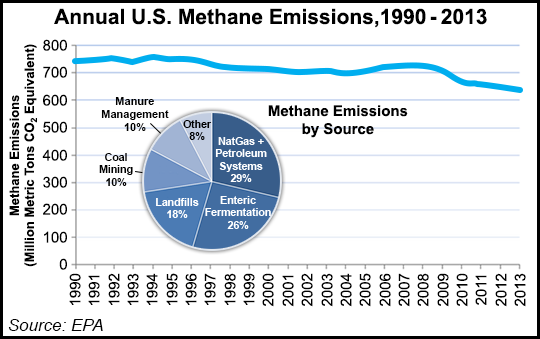Regulatory | NGI All News Access | NGI The Weekly Gas Market Report
EPA’s Oil/Gas Emissions Proposals Criticized at Public Hearing
Anger at the oil and natural gas industry was evident Tuesday at the U.S. Environmental Protection Agency’s (EPA) public hearing in Pittsburgh about its proposals to cut methane emissions from wells and downstream equipment, as testimony was primarily given by industry opponents.

The hearing followed two others in Denver and Dallas as the agency collects public comments on its latest proposal to cut greenhouse gas emissions. About 50 people filled a room for the afternoon session on the 13th floor of the William S. Moorhead federal building in downtown Pittsburgh. Most were activists, industry opponents and representatives from environmental organizations that consistently argued that the EPA’s proposed rules do not go far enough. Many of the 95 that signed up to speak supported the proposals and advocated for tougher rules for the industry.
“My conclusion is that if you control methane at various points in the process — not just during fracking, but after — it’s going to help us control local air toxins,” said Jeanne Wagner, a resident of Westmoreland County, PA, who said the density of drilling operations in her area would likely lead to her family moving. “There’s tons of things; there’s pipelines, there’s leaks, there’s blowdowns. My children are in danger at school, at home and in the community. And I believe we strongly need to monitor methane at all the levels, including these pipelines where there’s pigging operations that have blowdowns on a regular basis.”
The EPA proposed a suite of new rules in August to complement standards it rolled out for the industry in 2012 (see Daily GPI, Aug. 18). They include finding and repairing leaks, capturing natural gas from the completion of hydraulically fractured oil wells and limiting emissions from new and modified pneumatic pumps and downstream equipment. The proposals are a key component of President Obama’s plan to cut methane emissions from the oil and gas sector by 40-45% from 2012 levels by 2025 (see Daily GPI, Jan. 14).
Melanie Houston, director of water policy and environmental health for the Ohio Environmental Council, noted that Ohio has nearly 1,600 horizontal Utica Shale wells drilled and about 75 compressor stations proposed, operating or in development. She referenced blowouts and large well fires that have taken place in the state over the last year and implored the four EPA officials gathered to hear testimony to push for tighter emissions standards.
“To me, this [industry] represents a loss of control for these folks over the quality of air around their home and the immediate environment around their home,” Houston said of people living near areas of dense oil and gas development. “These folks deserve protection. They need this rule and they need it as soon as possible. And they need a rule to address existing sources, as many of my colleagues have talked about here today, not just new and modified sources. So, we ask that the oil and gas industry be made responsible for their pollution.”
Speakers from Ohio and Pennsylvania complained of areas overrun with oil and gas wells, associated infrastructure and related activity. One Pennsylvania resident said there are at least 27 unconventional wells within a few miles of her home. Another called on the EPA to pursue and phase-in an outright ban on fossil fuels.
Chief among the complaints were concerns about the EPA’s aggressive proposals to cut emissions from new and modified sources as the country’s oil and gas operations grow with the shale boom. Joanne Kilgour, Pennsylvania state director for the Sierra Club, said that by 2018 nearly 90% of all methane emissions would come from existing sources.
But while the EPA is proposing standards for new and modified oil and gas sources, it’s also suggesting that operators find and repair leaks, which have been identified as a significant source of volatile organic compounds (VOC) and methane leaks. The EPA’s draft guidelines for the states would also reduce VOC emissions from existing oil and gas sources in areas with smog problems.
An EPA report issued earlier this year found that methane emissions from natural gas production have fallen about 38% since 2005, but emissions from processing increased by about 38% since that year and rose about 11% from gas transmission and storage sources. Methane emissions from hydraulically fractured natural gas wells have declined by about 79% since 2005, the report said.
Earlier in the day, the Marcellus Shale Coalition’s Eric Cowden questioned the EPA’s proposal to interfere with what he said have been successful efforts at the state level to curb methane emissions. An American Petroleum Institute representative also noted during testimony that the industry has voluntarily improved its operations, emissions recovery and reduced its pollutants, warning that strengthening EPA standards could hamper those efforts with a “one-size-fits-all” approach.
An EPA spokesman said that 45 other attendees attended the Pittsburgh hearing, but did not testify. He noted that interested parties can email, fax or mail their comments about the EPA’s proposals until mid-November, when the public comment period ends.
© 2024 Natural Gas Intelligence. All rights reserved.
ISSN © 1532-1231 | ISSN © 2577-9877 | ISSN © 1532-1266 |
